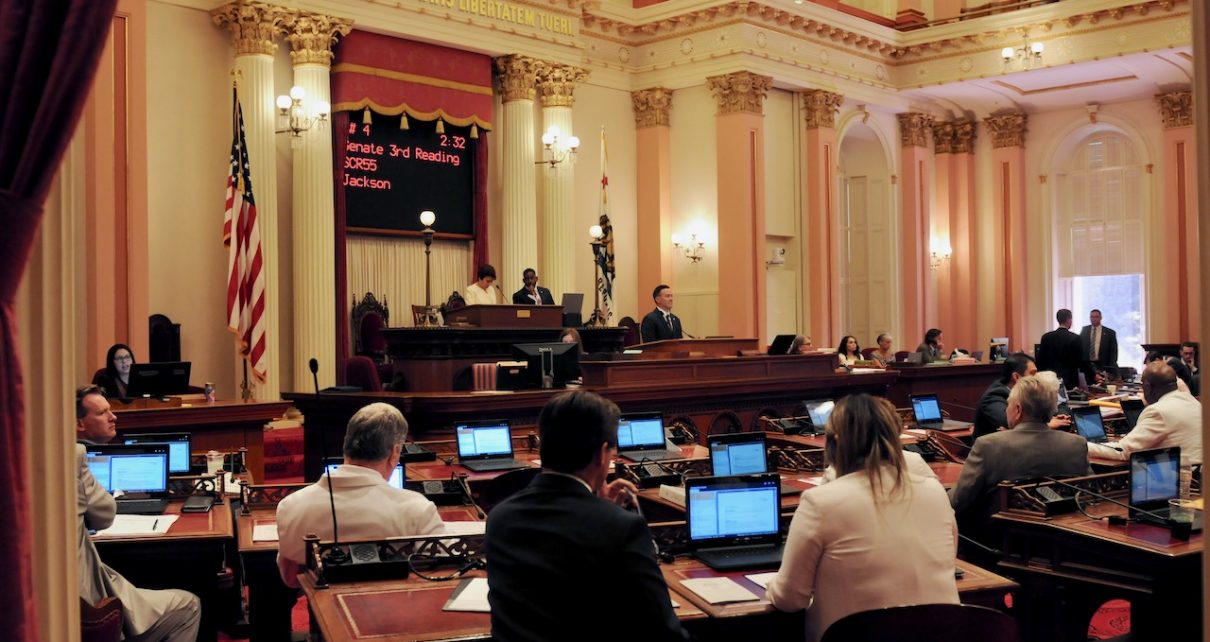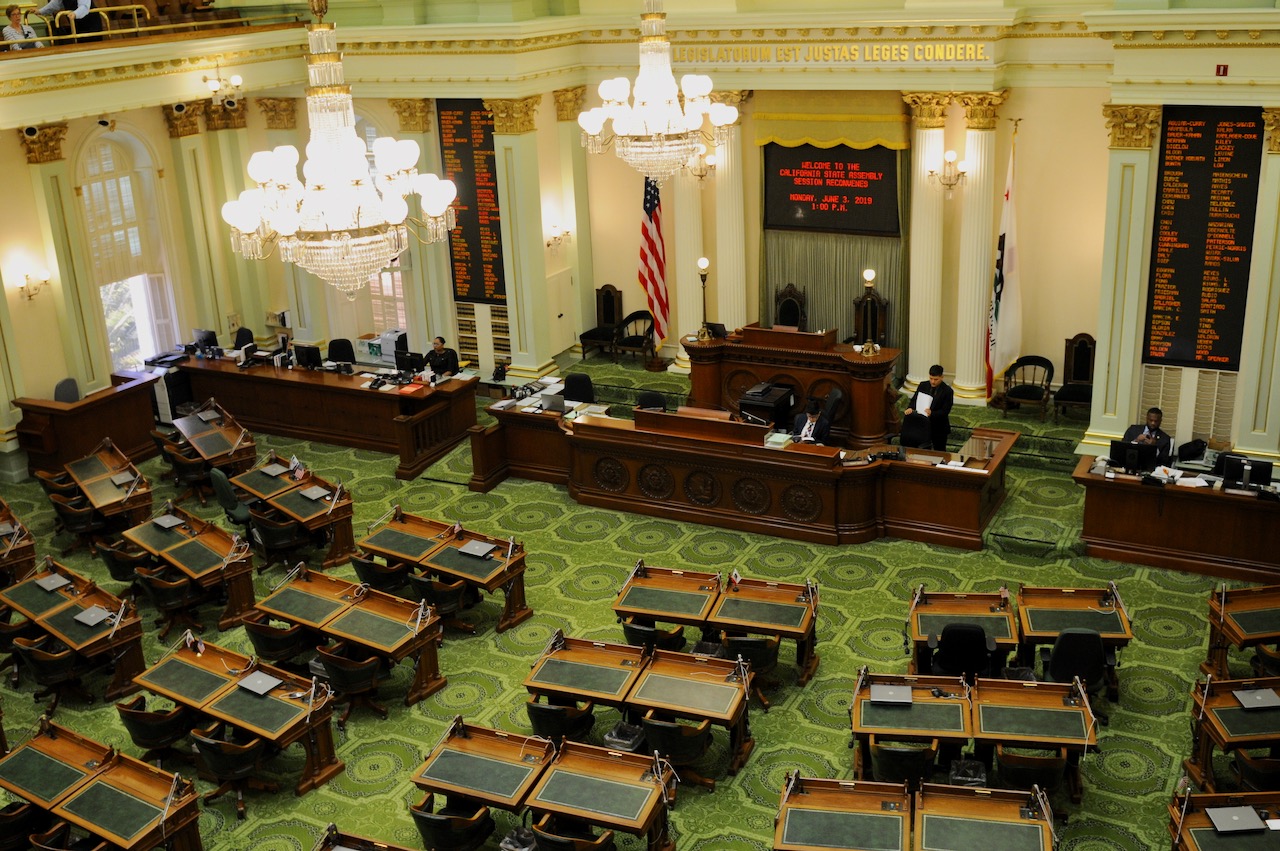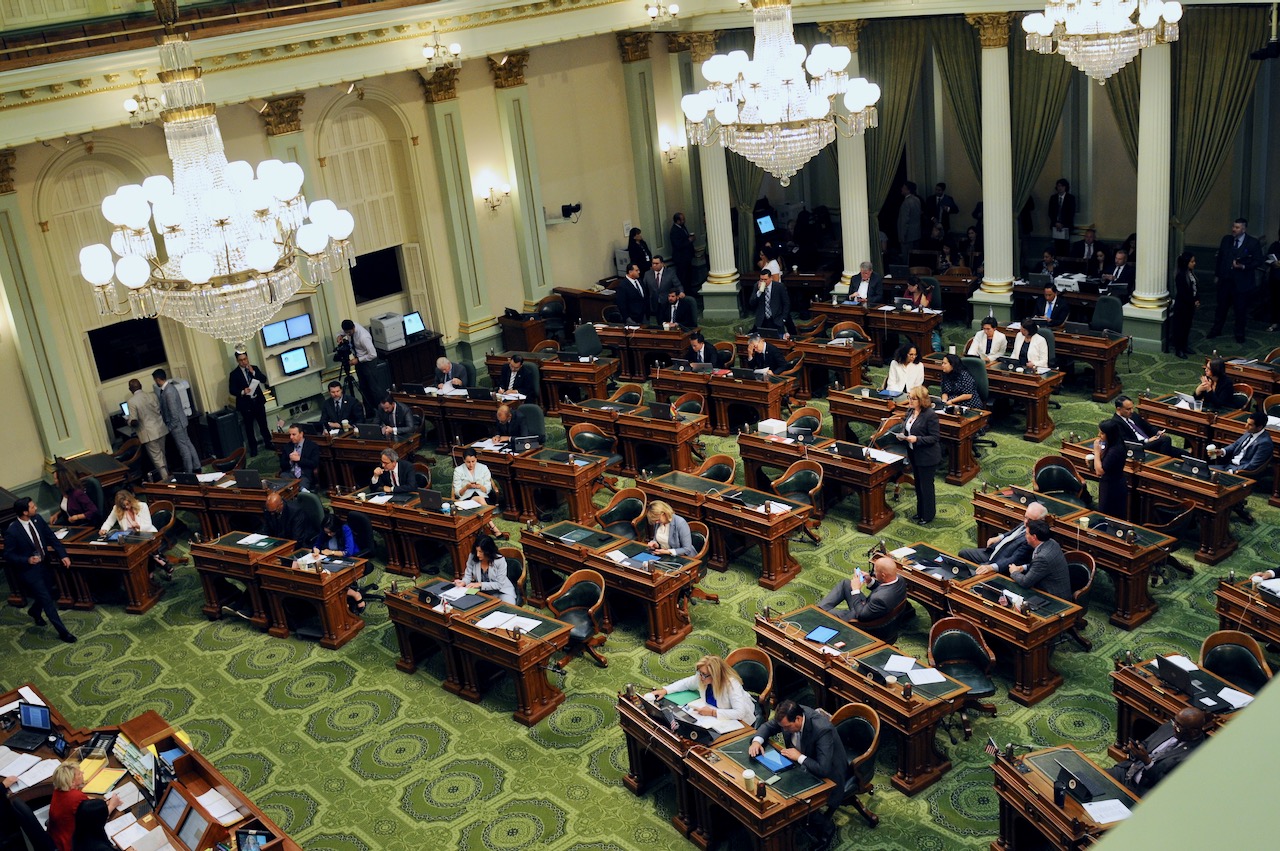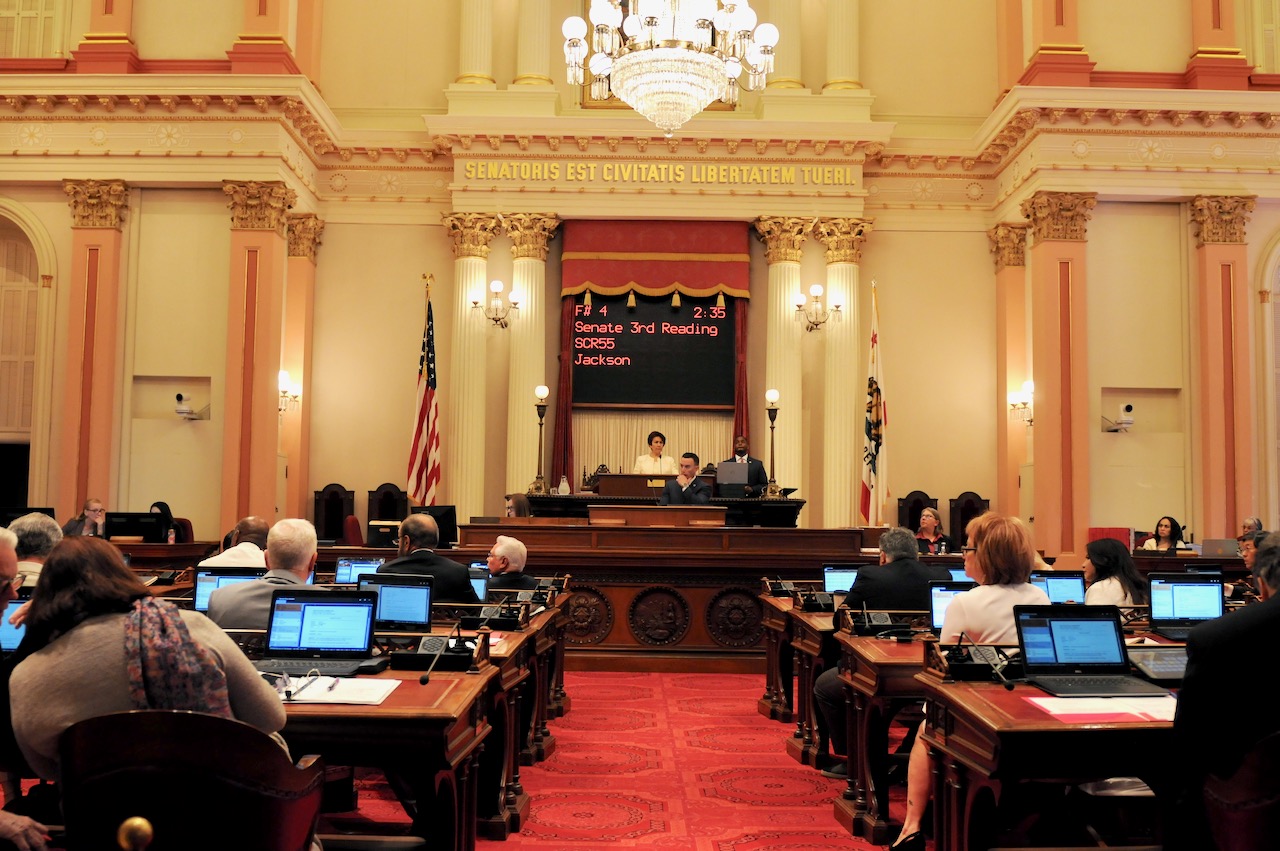
California State Senate. (Photo: Kevin Sanders for California Globe)
A Review of Joint Committees in the CA Legislature
The following is a brief summary of the eight joint committees
By Chris Micheli, September 30, 2022 10:00 am
The California Legislature has eight joint committees, which are defined by the Office of Legislative Counsel as “a committee composed of equal numbers of Assembly Members and Senators.” The Joint Rules of the Senate and Assembly have, among their numerous provisions, Joint Rule 36.5 which is applicable whenever a joint committee is created by a statute or resolution that either provides that appointments be made and vacancies be filled in the manner provided for in the Joint Rules, or makes no provision for the appointment of members or the filling of vacancies.
Pursuant to JR 36.5, the Senate members of a joint committee are appointed by the President pro Tempore of the Senate, while the Assembly members of a joint committee are appointed by the Speaker of the Assembly.
In addition, Joint Rule 36.7 concerns the appointment of joint committee chairpersons. JR 36.7 provides that the chairperson of each joint committee, except the Joint Legislative Budget Committee and the Joint Legislative Audit Committee, are appointed by the Joint Rules Committee from a Member or Members selected by the President pro Tempore of the Senate and the Speaker of the Assembly. The Chairpersons of the Joint Rules Committee and the Joint Legislative Budget Committee are selected based upon Joint Rule 40 and Joint Rule 37, respectively.
The following is a brief summary of the eight joint committees:
Joint Committee on the Arts
This joint committee was created by Resolution Chapter 101, Statutes of 1984. It is in continuous existence and there are 12 members, 6 Assembly Members and 6 Senators.
According to its web page: “Recognizing that the Arts contribute significantly to the quality of life in California; play an important role in the identity, innovation and economy of this state; and citing the dramatic decline in arts education programs in the state’s public schools, the Joint Committee on the Arts was formed in 1984.
Core areas that the Committee is authorized and directed to study, investigate and analyze include:
- Goals appropriate to the future of the arts and cultural life of California and the role the Legislature and state government should play in achievement of these goals;
- Arts legislation in other states and at the federal level and recommendations for legislation in this state;
- The status of arts education in California;
- The economic impact of the Arts in California; and
- The budget and programs of the California Arts Council.”
Joint Committee on Fairs Allocation and Classification
This joint committee was created by Food and Agricultural Code Sections 4531, 4532, 4533, 4534, and 4535. It is in continuous existence and there are 14 members, 7 Senators and 7 Assembly Members.
Joint Committee on Fisheries and Aquaculture
This joint committee was created by Resolution Chapter 88, Statutes of 1981. It is in continuous existence and there are 8 members, 4 Assembly Members and 4 Senators.
According to its webpage: “Recognizing that Fisheries and Aquaculture contribute significantly to the quality of life in California and play an important role in the identity and economy of this state, the Joint Committee on Fisheries and Aquaculture was formed in 1981. Core areas that the Committee is authorized and directed to ascertain, study, and analyze include:
- Issues facing the fishing and aquaculture industries;
- Encouragement of seafood production, gainful seafood industry employment, and a healthy coastal economy;
- Conservation, restoration, and enhancement of fishery resources;
- Protection of California seafood consumers;
- Collection of valid and reliable data on the fishing and aquaculture industries;
- Resolution of conflicts concerning the fishing and aquaculture industries; and
- Oversight of executive branch activities concerning the fishing and aquaculture industries.
This Committee has made numerous legislative fisheries and aquaculture recommendations resulting in enactment of many laws but does not have any law enforcement powers.”
Joint Committee on Rules
This joint committee was created by Joint Rule 40. It is in continuous existence and there are 30 members, 15 Assembly Members and 15 Senators.
According to its web page: “The Joint Committee on Rules is not only responsible for approving events, exhibits, and equipment for events, but also has a legislative purpose. This committee has and may exercise all of the rights, duties, and powers conferred upon investigating committees and their members by the Joint Rules of the Senate and Assembly.”
JR 40(a) provides, among other provisions, that the Joint Rules Committee is hereby created. The committee has a continuing existence and may meet, act, and conduct its business during sessions of the Legislature or any recess thereof.
The committee shall ascertain facts and make recommendations to the Legislature and to the houses thereof concerning:
(1) The relationship between the two houses and procedures calculated to expedite the affairs of the Legislature by improving that relationship.
(2) The legislative branch of the state government and any defects or deficiencies in the law governing that branch.
(3) Methods whereby legislation is proposed, considered, and acted upon.
(4) The operation of the Legislature and the committees thereof, and the means of coordinating the work thereof and avoiding duplication of effort.
(5) Aides to the Legislature.
(6) Information and statistics for the use of the Legislature, the respective houses thereof, and the Members.
In addition, any matter of business of either house, the transaction of which would affect the interests of the other house, may be referred to the committee for action if the Legislature is not in recess, and shall be referred to the committee for action if the Legislature is in recess.
Joint Legislative Audit
This joint committee was created by Government Code Sections 10501 and 10502, as well as Joint Rule 37.3. It is in continuous existence and there are 14 members, 7 Assembly Members and 7 Senators.
JR 37.3 provides, among other provisions, that the Joint Legislative Audit Committee is created pursuant to the Legislature’s rulemaking authority under the California Constitution, and pursuant to Chapter 4 (commencing with Section 10500) of Part 2 of Division 2 of Title 2 of the Government Code.
In addition, the Chairperson of the Joint Legislative Audit Committee, upon receiving a request by any Member of the Legislature or committee thereof for a copy of a report prepared or being prepared by the California State Auditor, shall provide the Member or committee with a copy of the report when it is, or has been, submitted by the California State Auditor to the Joint Legislative Audit Committee.
Joint Legislative Budget
This joint committee was created by Government Code Sections 9140 and 9141, as well as Joint Rule 37. It is in continuous existence and there are 16 members, 8 Senators and 8 Assembly Members.
JR 37 provides, among other provisions, that there is a joint committee to be known as the Joint Legislative Budget Committee, which is hereby declared to be a continuing body.
In addition, it is the duty of the committee to ascertain facts and make recommendations to the Legislature and to the houses thereof concerning the State Budget, the revenues and expenditures of the state, and the organization and functions of the state and its departments, subdivisions, and agencies, with a view to reducing the cost of the state government and securing greater efficiency and economy.
The committee has authority to appoint a Legislative Analyst, to fix the Legislative Analyst’s compensation, to prescribe the Legislative Analyst’s duties, and to appoint any other clerical and technical employees as may appear necessary. The duties of the Legislative Analyst are as follows:
(1) To ascertain the facts and make recommendations to the Joint Legislative Budget Committee and, under its direction, to the committees of the Legislature concerning:
(a) The State Budget.
(b) The revenues and expenditures of the state.
(c) The organization and functions of the state and its departments, subdivisions, and agencies.
(2) To assist the Senate Committee on Appropriations, the Senate Budget and Fiscal Review Committee, and the Assembly Committees on Appropriations and Budget in consideration of the Budget, all bills carrying express or implied appropriations, and all legislation affecting state departments and their efficiency; to appear before any other legislative committee; and to assist any other legislative committee upon instruction by the Joint Legislative Budget Committee.
(3) To provide all legislative committees and Members of the Legislature with information obtained under the direction of the Joint Legislative Budget Committee.
(4) To maintain a record of all work performed by the Legislative Analyst under the direction of the Joint Legislative Budget Committee, and to keep and make available all documents, data, and reports submitted to the Legislative Analyst by any Senate, Assembly, or joint committee. The committee may meet either during sessions of the Legislature, any recess thereof, or after final adjournment, and may meet or conduct business at any place within the State of California.
Joint Legislative Committee on Climate Change Policies
This joint committee was created by Government Code Section 9147.10. It is in continuous existence and there are 8 members, 4 Assembly Members and 4 Senators.
According to its web page: “The Joint Legislative Committee on Climate Change Policies (JLCCCP) was created in 2016 by AB 197 (E. Garcia). The JLCCCP was established to provide ongoing and permanent oversight over the implementation of the state’s climate policies. Consisting of at least three Senators and three Assemblymembers, this committee is required to make recommendations concerning the state’s programs, policies, and investments related to climate change.
The JLCCCP is also authorized to establish a panel of experts to provide an independent analysis of the state policies. The committee is uniquely positioned to connect the jurisdictions of several legislative standing committees, including those that have the issues of air quality, transportation, energy, and local government within their jurisdiction. The JLCCCP provides a critical perspective that is necessary to oversee integrated climate change policies throughout the activities of many state, regional, and local agencies.”
Joint Legislative Committee on Emergency Management
This joint committee was created by Resolution Chapter 31, Statutes of 2011. It is in continuous existence and there are 14 members, 7 Senators and 7 Assembly Members.
According to its web page, “Primary jurisdiction includes disaster preparedness, emergency management, and homeland security issues.”
- Purchases of Federal and State Surplus Property in California - February 12, 2025
- Objections to Pleadings - February 11, 2025
- Remedies and Penalties in State Contracting - February 10, 2025





One thought on “A Review of Joint Committees in the CA Legislature”